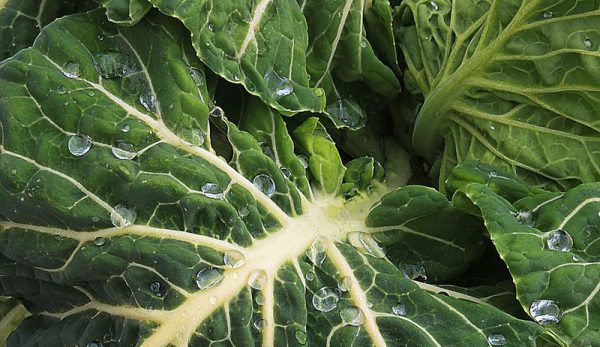
You might be wondering why leafy greens are all the rage in cool-season gardens. They may not be gorgeous like bright-red tomatoes or have show-stopping flowers like okra, but leafy greens are nutritional powerhouses, versatile in the kitchen, and hardy even after a frost.
Collard greens—a No. 1 leafy green in my garden—are a crop celebrated in the South and central to African-American history.
You may hear about the seeds of collard greens being brought to the US by enslaved Africans. The truth is that collards originated in the Mediterranean and were probably brought here by Europeans.
Enslaved people in the Southern U.S. incorporated these greens into their diets, as collards were often made available to them and were similar to the wild and cultivated greens they knew in their home countries. (Let culinary historian Michael Twitty educate you.)
How to Grow Collard Greens
A member of Brassica oleracea, collard greens grow best in cool-season gardens, though summer harvest is not unheard of, as I managed in my garden this year. They slowed down a bit during peak heat but never quit producing.
For spring and summer gardens, start your seeds indoors in late winter, or direct seed in early spring. For fall gardens, direct seed in late summer. Here in Central Kentucky, we seeded our fall collards in early August. You want to give your fall collards at least two months to grow before frost hits them, if possible.
Fall collards will overwinter in many parts of the U.S. During Persephone Days—when there’s 10 or fewer hours of light per day—leaf growth will slow significantly, but it’ll pick up again after that, meaning you’ll be harvesting collards again in late winter and early spring.
Plant collard greens in full sun in deep soil. According to Texas A&M AgriLife Extension, the roots of a collard plant easily reach depths of 2 feet of more. This explains how collards can tolerate drought and stay productive for so long—they mine nutrients and moisture from that depth.
Give your plants 18 inches or more between them, and they’ll spread their leaves to match the space.
If you’re growing your collard plants for more than a few months, side-dress with fertilizer to give them a boost as seasons change.
Collards have little issue with disease, but they are a favorite of cabbage loopers, aphids and harlequin bugs. Keep them covered (more on that below), try a soap spray or use Bacillus thuringiensis when the pests are too much.
Here’s how to identify and manage 4 common kale pests.
How to Extend Collards’ Life
For spring/summer gardens, collards are likely to slow their production of greens as temps peak and dry spells set in. I know farmers who just leave their collard plants alone for a month or more, then come back to them for harvest when they start growing again.
For fall gardens, collard greens will survive frosts—and become sweeter, as the cold concentrates their sugars—and can go uncovered to 20 degrees or so.
Floating row cover is a smart move for growing collards in any season, as it’ll keep the cabbage loopers and other insects away from the plants, as well as extend the plants’ life into the colder months.
How to Harvest and Store Collard Greens
Harvest first thing in the morning so the leaves are as crisp and fresh as possible.
Wait until the leaves grow at least as big as your hand before snapping the stem at its base. Some collard varieties will get as big as your face—and bigger—so don’t be in too much of a rush to harvest.
Store collards in a plastic bag or wrapped in damp paper towels in your fridge. They’ll keep for a week or more.
Blanch, chop and freeze greens that you’re not eating right away.
Try some new plants in your fall garden this year—here are a few suggestions.
How to Eat Collard Greens
I can’t pretend to be a collards expert, as I wasn’t introduced to collard greens until I started working on a farm in the South six years ago. But I know there are gloriously delicious ways to prepare collards by stewing them with fatback and smoked ham hocks—and typing that made my mouth water—and I encourage you to seek out recipes in that tradition!
I love collard greens the same as I do kale, mustard and chard, and sometimes I mix all of these for a sauté with onions, finished with vinegar. (I know I’m offending Southern sensibilities here!) Top that with a fried egg, and call it breakfast.
With a nod to fusion cooking, I love adding thinly sliced collards to miso soup. I love adding collards to most brothy soups, really, just at the end so they’re cooked but not mushy.
The sturdy leaves can stand in as the tortilla for your wrap, too.
Collard greens’ ability to produce when the weather turns too cold for many other veggies ensure their place in my fall and spring gardens. It doesn’t hurt that I love their large, vibrant, green leaves, and their taste is pretty good, too.




